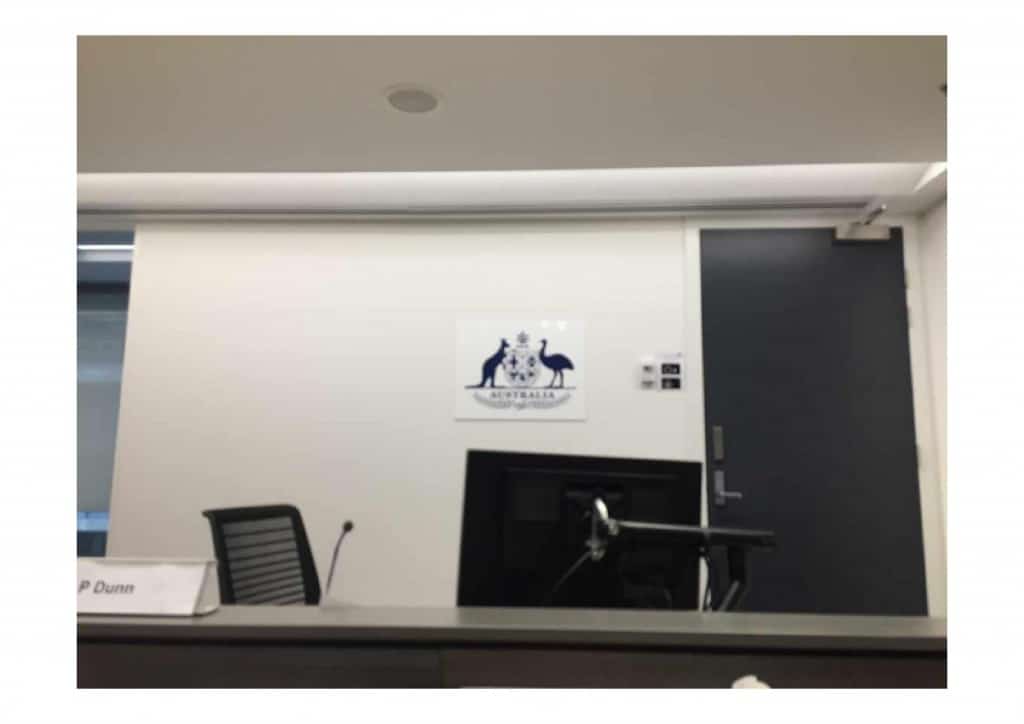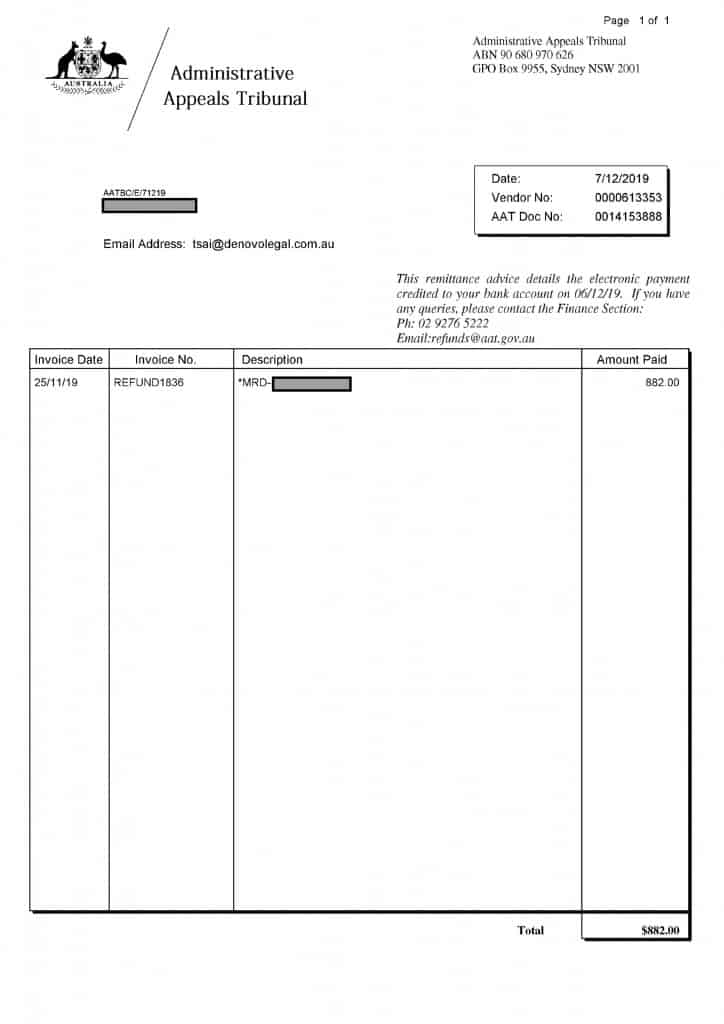
AAT Hearing When & How – When should you lodge your review application? How to apply for AAT hearing?
You may be eligible to apply for AAT hearing if the Department of Home Affairs (Department) refused your visa application, you will receive a notification of the refusal and a decision record detailing the reason(s) why it was refused and you must know When & How to apply. Click here to learn which types of decision that can be reviewed by the AAT.
Methods of notifying visa refusal
The Department may use the following methods to notify you of a refusal to grant you the visa you applied:
- By hand, including by way of an authorised officer, when handing you the notification. If you have been given the notification by hand, you are taken to have received the notification when it is handed to you.
- Handing to a person (a person who appears to be over 16 who live or work) at your last residential or business address if an address was provided for the purposes of receiving documents. If the other person have been given the notification by hand at the residential or business address, that person is taken to have received the notification when it is handed to the other person.
- By post or other prepaid means within 3 days of the refusal notification date to the last address (residential or business) for service provided by you to the Department for the purposes of receiving documents. If the notification was posted in Australia to the address in Australia by prepaid post or other prepaid means, you are taken to have received the notification within 7 working days after the date of the notification as appeared on the notification letter and in any other case – 21 days after the date of the notification.
- By fax, email or other electronic means to the last fax number, email address or other electronic address that you provided to the Department for the purposes of receiving documents. If the notification was faxed or emailed or by other electronic means, you are taken to have received the notification at the end of the day on the notification is transmitted.
- By giving to your career if you are a minor. Date of notification depends on (1) – (4) above.
In the event the Department has made a mistake in notifying you but you nevertheless received the notification, you are deemed to have received the notification at the time (depending on the method) mentioned above, unless you can show that you received it at a later time then you are deemed to have received the notification at that time.
Who can apply for AAT hearing
Depending on the type of application, the person who may be able to apply for AAT hearing can be you (the visa applicant) or your sponsor or nominator or a relative or a prescribed person.
How to apply for AAT hearing
As a rule of thumb, if you are in Australia when you applied for a visa and when you received the Department’s refusal, you may apply for a AAT hearing. However, the AAT may only be able to conduct a hearing if you applied within the statutory time frame.
You can lodge an application on paper or make an online application for an AAT hearing (click here to apply).
The Migration Act required any notification of the refusal decision to ‘state …. the time in which an application for review may be made’ and you must be notified in the prescribed way. It is only when you have been notified that time begins to run.
When to apply for AAT hearing
The deadline for making an application for an AAT hearing depends on whether you have made an application for a protection visa (commonly known as a Part 7 Reviewable Decision) or other visa (commonly known as a Part 5 Reviewable Decision), and whether the Department notified you by post or by email or by other methods.
If you have been notified of the refusal by post, you are taken to have received the notification on the 7th day after the date on the notification letter.
If you have been notified of the refusal by email, you are taken to have received the notification at the end of the day the email was sent.
If you have applied for, eg, a protection visa (Part 7-reviewable decision) you must apply for AAT hearing within 28 days after you have been notified of the refusal or within 7 days if you are currently in immigration detention. For eg, if the refusal notification was dated 24 February 2019 and it was sent by registered post on 25 February 2019, it is said that the notification has arrived 7 working days after the date of the notification (ie 24 February 2019) as long as it was dispatched within 3 days of the date of the notification. The actual day of dispatch does not matter as long as it was sent within the 3 day window. When the notification was posted, it is said that notification was received on 05 March 2019.
As you are deemed to have received the notification on 05 March 2019, you must apply for your AAT hearing within a further 28 days of that date.
Note: if by email or fax, it is just 28 days starting on the day the email is sent, so the review must be lodged before the end of the 27th day after the email was sent.
It is obviously quite difficult to know when you must apply for an AAT hearing because the notification does not actually state the actual date by which you must apply. This is because the law simply requires the notification should state ‘the time in which the application for review may be made’. This is a reference to a period and not a date.
Part 5 reviewable decision – Deadline for AAT review (section 347)
Deadlines start when the applicant receives the notification and ends after day on which the notice is received.
Reg. 4.10 dictate the deadline to apply to AAT for a Part 5 reviewable decision.
- 21 days – for onshore temporary visa where a valid nomination is required or is a decision not to approve the sponsor under s 140E or not to approve the nomination under s 140GB (s338(2) – TSS 482) or offshore application for a permanent visa (s 338(7A)); reg. 4.10(1((a)).
- 7 working days – for onshore visa cancelled excluding visa cancelled while in immigration clearance (s 338(3)) or visa cancelled for providing incorrect info under s 109 (s 133A) or visa cancelled under s 116 discretionary power (s133C) or cancellation of business visa for failing to obtain a substantial ownership in an eligible business (s134(1)) or cancellation of a business visa of a MOFU because s/he is never a MOFU (s 134(4)) or visa cancelled for failing character test (s 501)
- 70 days – offshore application requiring sponsorship or nomination of an AUS citizen or PR or SCV 444 holder or a company operating in AUS (s 338(5)) or offshore application of a former AUS PR and is a parent or spouse or de facto partner or child or sibling who is an AUS citizen or PR (s 338(6)) or an offshore application to visit an AUS citizen or PR who is a parent or spouse or de facto partner or child or sibling – Family Sponsored Visitor FA 600 (s 338(7) or an offshore points (s 93) based application requiring sponsorship or nomination by an AUS citizen or PR or SCV 444 (s 338(8))
- 21 days – refusal to approve work agreement work sponsor under s 140E(1) or family sponsor under s 140E(1A) (s 338(9)).
- 28 days – covered by subs 338(9); prescribed (s 347(1)(b)(iii)
Student visa refusal
If the Department has refused your Student visa application and notified you through your email, you will have 21 days from the date you were notified of the decision. For example, if the Department emailed the decision to refuse your Student visa on the 20 January, you must apply and successfully lodge your AAT review application by the 10 February. If you have lodged your AAT review application on the 11 February, the Tribunal will write to you asking you to comment on the validity of your application. In any event, the Tribunal will conclude that your application has been lodged outside the statutory timeframes and therefore invalid. As your application for review was not made in accordance with the Migration Act 1958, the Tribunal is said to have no jurisdiction to hear your application.
In immigration detention (reg. 4.10(2))
- 2 working days – refusing to grant or cancel a bridging visa (s 338(4); reg. 4.10(2)(a))
- 2 working days – a visa requiring a security (reg. 4.02(4)(f)); reg. 4.10(2)(aa)
- 7 working days – if none of the above
Instruction from the Department must be complete and clear
There is a requirement for the Department’s notification to ‘set out the information in each of the subsections in a way which is not only complete but clear as well”. The notification must not provide ‘piecemeal, entirely obscure and essentially incomprehensible” information.
The notification must not refer to the time in which the AAT hearing application may be made in different sections across different pages. For eg, the calendar date of sending or transmission is located on a different page or in a different section. Placing of information as to when the notification is taken to have been received in an incorrect heading can be confusing and misleading and it may not be taken to mean when you must apply for AAT hearing is met.
The notification should not require you to assemble the information from disparate parts of the notification to arrive at the correct conclusion does not comply with the requirement of clarity.
How AAT perform its duty
The AAT’s duty is to make the correct and preferable decision using the evidence (including what you say during the hearing). The AAT can adopt whatever immigration policy it chooses, or no policy at all (but must have regard to the policy) in conducting the hearing: Re Drake and Minister for Immigration and Ethnic Affairs (No. 2) (1979) 2 ALD 634 at [640].
At the AAT review, the question is not whether the Department’s decision made was the correct or preferable one. The question for the AAT is whether the decision was the correct and preferable one on the evidence for it: Drake v Minister for Immigration and Ethnic Affairs (1979) 46 FLR 409 at [page 11]. In addition, it is for the AAT to reach its own decision using the evidence, including any new, fresh, additional or different evidence that had been received by the Tribunal as relevant to its decision.
The AAT is independent of the Department and is free to adopt reasoning entirely different from the reasoning which led to your visa refusal or visa cancellation.
Providing new evidence:
In addition, you should be aware that under the Administrative Appeals Tribunal (AAT) Act 1975, the AAT is in the shoes of the original decision maker and applications for a review of the Department’s decision will be based upon the evidence available to the AAT at the time of its hearing, some of which may not have been available to, or before, the original decison-maker at the time of their determination (Shi v MARA [2008] HCA 31 at [37] per Kirby J).
If for some reasons you and/or your immigration lawyer are unable to attend the scheduled hearing, you can request for the hearing to be postponed (click here to learn more).
You should note that sometimes the Tribunal may ask you to provide information before or after the hearing, if you receive such a request, you should provide the information (click here to learn more).

Refund of AAT application fee
If the AAT remits or set aside the Department’s Decision to refuse or cancel your visa or substitute the Department’s Decision to refuse your application (eg, nomination application), the Tribunal will refund half of your AAT application fee.
In some cases the Tribunal may be able to grant you the visa, click here to learn more.
Australian migration law is complex and difficult to understand, contact our immigration lawyer for a consultation (fee applies) or click here to find answers to your questions or click here to learn if you should engage a migration lawyer or migration agent to help you with your AAT hearing.

 041 222 4020 or WeChat: AUDvisa
041 222 4020 or WeChat: AUDvisa
This article is not intended to be or taken as migration legal advice. The author of this article disclaims any liability for any action or omission on the information provided or not provided in this article. You should always consult an immigration lawyer or a registered migration agent to form an informed opinion on your immigration matter.



